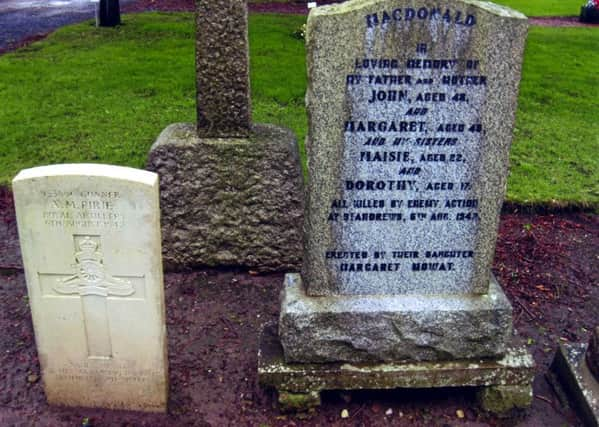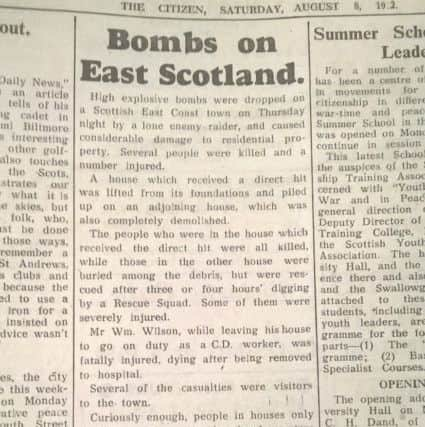When the bombs rained on St Andrews...


Amongst them, and alongside the grave of a family who met their deaths on the same day, is Gunner Alexander Pirie of the Royal Artillery.
The two headstones are the only memorial to the night St Andrews was bombed during the Second World War.
Advertisement
Hide AdAdvertisement
Hide AdIt happened on August 6, 1940, and the Citizen reported very briefly in its issue dated August 8: “High explosive bombs were dropped on a Scottish East Coast town on Thursday night, by a lone enemy raider, and caused considerable damage to residential property. Several people were killed and a number injured,” the report began.


Dramatically it recorded: “A house which received a direct hit was lifted from its foundations and piled up on an adjoining house, which was also completely demolished”.
The report goes on to record the deaths of all of those in the Nelson Street house that received the direct hit, but the family in the second house were dug out of the rubble alive although severely injured. The longer report a week later records: “While they were being rescued the old mother cheered up her daughters by telling them that the men were working hard to get them out.”
The August 15 Citizen report says that the bombing was the work of a single German bomber and that 12 people were killed, a number seriously injured, and considerable damage done to houses.
Advertisement
Hide AdAdvertisement
Hide AdThe family in the house that received the direct hit are believed to have been holidaying in St Andrews and were John and Margaret MacDonald and two of their daughters Maisie and Dorothy.


They were buried in the Western Cemetery and the gravestone records: “all killed by enemy action at St Andrews, 6th Aug 1942.” the stone lists a third daughter, Margaret, who erected the memorial.
The Citizen does not record who the”tenant” of the house was, but a booklet from St Andrews Preservation Trust records the death in the bombing of Mr Albert Brown of Almar in Nelson Street.
Mr Brown was the ARP warden, and is the only civilian recorded on St Andrews war memorial.
Advertisement
Hide AdAdvertisement
Hide AdThe other recorded fatality was Mr William Wilson, of Wilson’s Garage in South Street. He was a member of the local Rescue Squad and was on his way to go on duty when he was killed by a falling stone.
The five other victims of the bombing remain unidentified.
And then there was young Alexander Pirie whose presence in St Andrews that fateful night remains unexplained. It is known that his home was in Langside, Glasgow, and following the bombing a notice in the Citizen thanked the town for its support: “The parents and friends of Gunner Alex M Pirie, RA, return sincere thanks and appreciation for the kindness and floral tributes received in their bereavement.”
The town rallied round those who lost their homes and possessions in the raid – the Women’s Voluntary Service helped out at the rest centre where those rendered homeless given meals and provided with sleeping accommodation, the Girl Guides helped families restore their homes to order and mobile canteens were set up to cater for volunteer helpers and victims.
Both of the Citizen’s reports record that poor blackouts had, perhaps, attracted the German bomber: “There has been much criticism about defective black-outs in this district,” the paper reported.
Advertisement
Hide AdAdvertisement
Hide AdBut this disastrous event was not the only time St Andrews was bombed during the war. St Andrews Preservation Trust has recorded another bombing in October 1940 when eight bombs landed on St Andrews, Kenley Green, Boarhills and Brownhills.
No injuries were recorded, but damage was done – a house demolished, the university’s Bute Building was damaged and a bomb landed at the south end of the quadrangle of St Mary’s College.
The Citizen then reported: “The spirit of the people was revealed when the raid was over. As if by magic a Union Jack was seen flying proudly above one of the craters.”
The Commonwealth War Graves Commission looks after cemeteries and burial grounds of men and women who died in the two world wars.
Advertisement
Hide AdAdvertisement
Hide AdThe organisation commemorates the 1,700,000 men and women in cemeteries, burial plots and memorials at 23,000 locations, which are a lasting tribute to those who died in some 154 countries across the world.
Commonwealth war graves are scattered across Fife, from single graves for example at Boarhills, to 60 at Leuchars and more than 250 at two cemeteries in Dunfermline.
Beautifully maintained the cemeteries are a moving reminder of war’s “brutality, its futility, its stupidity” in the words of Dwight D Eisenhower.